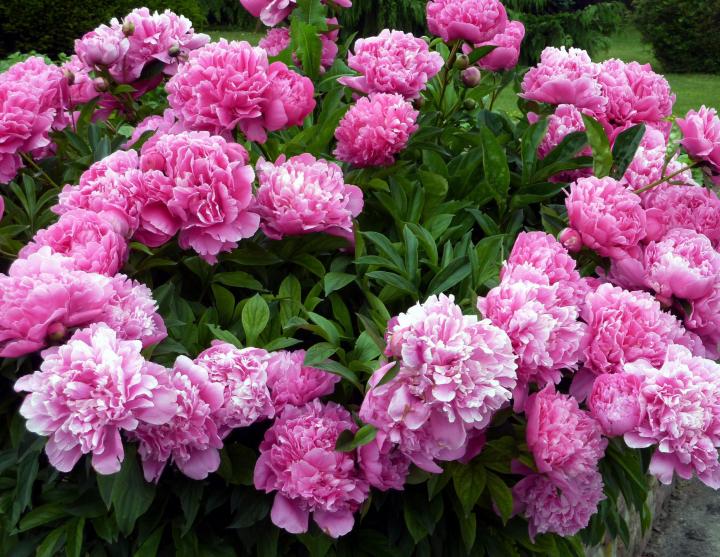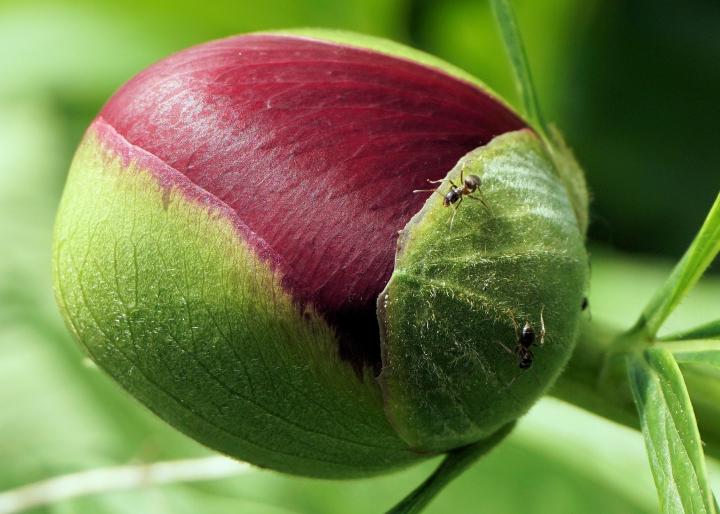Growing Peonies
How to Plant, Grow, and Care for Peony Flowers
How to Plant, Grow, and Care for Peony Flowers

Pixabay
The peony is outrageously
beautiful in bloom in springtime—with lush foliage all summer long.
Here’s how to grow peonies and get the best peony flowers in
your garden.
Peony plants require little maintenance as long as they are planted properly and establish themselves; they do not respond well to transplanting.
They’re hardy to Zone 3 and grow well as far south as Zones 7 and 8. In most of the country, the rules for success are simply full sun and well-drained soil. Peonies even relish cold winters, because they need chilling for bud formation.
Peonies make fine sentinels lining walkways and a lovely low hedge. After its stunning bloom, the peony’s bushy clump of handsome glossy green leaves lasts all summer, and then turns purplish or gold in the fall, as stately and dignified as any shrub.
In mixed borders, peonies bloom with columbines, baptisias, and veronicas, and combine well with irises and roses. Plant white peonies with yellow irises and a froth of forget-me-nots; set off pink peonies with blue Nepeta or violets.
Planting
When to Plant Peonies
- Plant peonies in the fall if possible. Plant them a few weeks before the first fall frost (in late September and October in most of North America, and even later in the southern U.S.). If you must move an established plant, this is also the best time.
- Peonies should be settled into place before the first hard fall frost. Find your local frost dates here.
- It’s possible to plant peonies in the spring, but spring-planted peonies just don’t do as well, generally; they lag about a year behind those planted in the fall.
- If planting in the spring, plant as soon as the soil is workable (i.e., no longer frozen). While there’s still a risk of frost, place a 1 to 2 inch layer of mulch over the planting area. When temperatures begin to warm, remove this mulch (a thin layer may be left to help with moisture retention).
How to Plant Peonies
- Grow peonies in deep, fertile, humus-rich, moist soil that drains well. Soil pH should be neutral.
- The soil will benefit from the addition of organic material in the planting hole. If the soil is heavy or very sandy, enrich it with compost. Incorporate about 1 cup of bonemeal into the soil. Tamp soil firmly. Learn more about soil amendments and preparing soil for planting.
- Peonies are not fussy, but choose your location wisely, as they resent disturbance. Provide shelter from strong winds. Plant away from trees or shrubs as peonies don’t like to compete for food and moisture. Space them three to four feet apart for good air circulation.
- Peonies like full sun, and though they can manage with half a day, they bloom best in a sunny spot.
- Peonies are usually sold as bare-root tubers with three to five eyes, divisions of a three- or four-year-old plant.
- Dig a generous-sized hole, about two feet deep and two feet across in well-drained soil in a sunny spot. If the soil is heavy or very sandy, enrich it with compost. Incorporate about one cup of bonemeal into the soil. Tamp it firmly.
- Set the root so the eyes face upward on top of the firmed soil, placing the root just 2 inches below the soil surface. (In southern states, choose early-blooming varieties, plant them about an inch deep, and provide some shade.)
- Don’t plant too deep! In most of the country, the peony’s eyes (buds) should be no deeper than 1-½ to 2 inches below the soil line.
- Then, backfill the hole, taking care that the soil doesn’t settle and bury the root deeper than 2 inches.
- Water thoroughly.

Care
Like children, young peonies take time to develop. They usually need a few years to establish themselves, bloom, and grow.
Peonies thrive on benign neglect. Unlike most perennials, they don’t need to be dug and divided.
Peonies thrive on benign neglect. Unlike most perennials, they don’t need to be dug and divided.
- Spare the fertilizer. Work the soil well before you plant, mixing in a little fertilizer, and that should be enough.
- If your soil is poor, the time to apply fertilizer (bonemeal, compost, or well-rotted manure) is early summer, after the peonies have bloomed and you have deadheaded. Don’t fertilize more than every few years.
- Help the stems. If peonies have any structural weakness, it is their stems, which are sometimes not strong enough to support their gigantic blossoms. Consider three-legged metal peony rings that allow the plant to grow through the center of the rings.
- Deadhead peony blossoms as soon as they begin to fade, cutting to a strong leaf so that the stem doesn’t stick out of the foliage. Cut the foliage to the ground in the fall to avoid any overwintering disease.
- Don’t smother peonies with mulch. Where cold temperatures are severe, for the first winter after planting you can mulch VERY loosely with pine needles or shredded bark. Remove mulch in the spring.
Pests/Diseases
Peonies are generally very hardy. They are susceptible to Verticillium wilt, ringspot virus, tip blight, stem rot, Botrytis blight, leaf blotch, Japanese beetle, and nematodes.
Many gardeners wonder why so many ants crawl on the peony buds. They are eating nectar in exchange for attacking bud-eating pests. Never spray the ants; they’re helping you nurture peonies to bloom!

Luckily, peonies are also one of many deer-resistant plants you can grow in your garden.
Many gardeners wonder why so many ants crawl on the peony buds. They are eating nectar in exchange for attacking bud-eating pests. Never spray the ants; they’re helping you nurture peonies to bloom!

Luckily, peonies are also one of many deer-resistant plants you can grow in your garden.
Harvest/Storage
Peonies
make wonderful cut flowers, lasting more than a week. For best results,
cut long stems when the buds are still fairly tight.
Recommended Varieties
Peonies
are spring-bloomers, but you can plan your garden for a successive
display of flowers from mid-May to early June. Here are some choices:
- ‘Early Scout’: very early, red single flowers
- ‘Firelight’: very early, pale-pink single
- ‘Karl Rosenfield’: midseason double with large crimson blossoms
- ‘Norma Volz’: midseason large, white, fully double flower
- ‘Elsa Sass’: late-season double with pure-white, camellia-like flowers
Wit & Wisdom
Had I but four square feet of ground at my disposal, I would plant a peony in the corner and proceed to worship. –Alice Harding, The Book of the Peony
The fattest and most scrumptious of all flowers, a rare fusion of fluff and majesty, the peony is now coming into bloom.
–Henry Mitchell, American writer (1923-93)
Peonies are said to symbolize a happy life and a happy marriage. See more flower meanings here.
The fattest and most scrumptious of all flowers, a rare fusion of fluff and majesty, the peony is now coming into bloom.
–Henry Mitchell, American writer (1923-93)
Peonies are said to symbolize a happy life and a happy marriage. See more flower meanings here.
Many ESC fans from all over the world are so very sad because we lost Joy Fleming - one of the best singers ever.
Betty MacDonald fan club founder Wolfgang Hampel sings 'Try to remember' especially for Betty MacDonald fan club organizer Linde Lund at Vita Magica September
you can join
Betty MacDonald fan club
Betty MacDonald Society
Vita Magica
Eurovision Song Contest Fan Club
on Facebook
Vita Magica Betty MacDonald event with Wolfgang Hampel, Thomas Bödigheimer and Friedrich von Hoheneichen
Vita Magica
Betty MacDonald
Betty MacDonald fan club
Betty MacDonald fan club on Facebook
Betty MacDonald forum
Wolfgang Hampel - Wikipedia ( English )
Wolfgang Hampel - Wikipedia ( English ) - The Egg and I
Wolfgang Hampel - Wikipedia ( Polski)
Wolfgang Hampel - Wikipedia ( German )
Wolfgang Hampel - LinkFang ( German )
Wolfgang Hampel - Academic ( German )
Wolfgang Hampel - cyclopaedia.net ( German )
Wolfgang Hampel - DBpedia ( English / German )
Wolfgang Hampel - people check ( English )
Wolfgang Hampel - Memim ( English )
Vashon Island - Wikipedia ( German )
Wolfgang Hampel - Monica Sone - Wikipedia ( English )
Wolfgang Hampel - Ma and Pa Kettle - Wikipedia ( English )
Wolfgang Hampel - Ma and Pa Kettle - Wikipedia ( French )
Wolfgang Hampel - Mrs. Piggle-Wiggle - Wikipedia ( English)
Wolfgang Hampel in Florida State University
Betty MacDonald fan club founder Wolfgang Hampel
Betty MacDonald fan club interviews on CD/DVD
Betty MacDonald fan club items
Betty MacDonald fan club items - comments
Betty MacDonald fan club - The Stove and I
Betty MacDonald fan club groups
Betty MacDonald fan club organizer Linde Lund